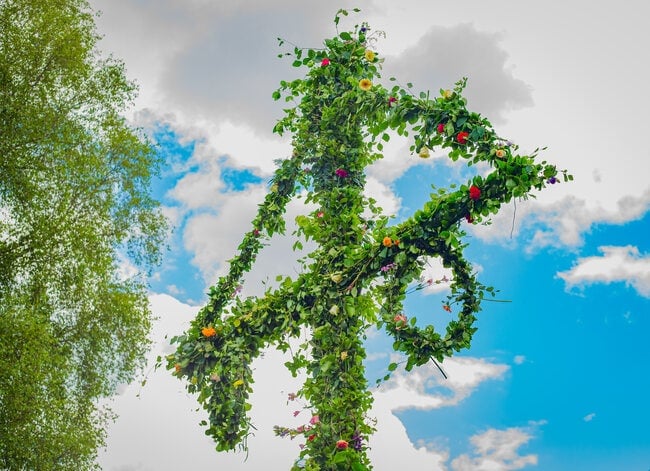If summer solstice marks the first day of summer, why is “Midsummer” just a few days later? Learn the origins of this special holiday and discover fun Midsummer celebrations for your friends and family!
Origins of Midsummer and St. John’s Day
Midsummer celebrates the joy of long, warm days spent outside in the summertime. It’s held near the summer solstice—the first day of summer and the longest day of the year in the Northern Hemisphere—and is believed to be a period of good fortune and fertility. It’s especially beloved in Scandinavia, where the sky stays light into the night. In Sweden (Midsommar) and Finland (Juhannus) are even national holidays.
Many Midsummer rituals and superstitions have ancient origins (in Finland, it’s thought the holiday may have been meant to keep the thunder and rain god Ukko happy, thus ensuring a bountiful harvest). Midsummer’s Eve also frequently coincides with St. John’s Eve, a night of festivities before the Feast Day of St. John, a Catholic holiday marking the nativity of St. John the Baptist on June 24.
These days though, Midsummer celebrations are more revelrous than religious, a time to gather with friends and family outdoors for eating, drinking, and merry-making.
When is Midsummer 2026?
Sweden celebrates on a Friday between June 19 and 25, while Finland parties on a Saturday between June 20 and 26. This year, Midsummer Eve falls on Friday, June 19, 2026 and Midsummer Day falls on Saturday, June 20, 2026.

Folklore and Celebrations
Because summer is a great time for a party, Midsummer has long been a time of revelry. The early Catholic church capitalized on this by creating the Feast of St. John the Baptist on June 24, six months before Christmas, to coincide with Midsummer (according to the Gospel of Luke, John the Baptist was born six months before his cousin, Jesus, which is why this is a fixed date on the 24th). Many of the traditional festivities associated with St. John’s feast day were held the night before, on June 23, or St. John’s Eve.
Perhaps more than any other day of the year, except Christmas, St. John’s Eve is full of lore. Throughout the world, this night has traditionally been celebrated by lighting massive bonfires, accompanied by music, singing, and dancing. In fact, in Ireland, St. John’s Eve is still known as “Bonfire Night,” and its history stretches back even further than Catholicism in Ireland. At one time, Bonfire Night honored Ãine, the Celtic goddess of love and fertility.
St. John’s Eve bonfires were believed to have magical, protective qualities, and many rituals sprang up around them.
- Jumping through the fire was said to bring good luck. Farmers walked in circles around their sheep, carrying torches lit from the bonfire. In certain areas of Ireland, some people still believe that…
- If you hold a pebble in your hand while circling a Midsummer bonfire, any wish will be granted. Simply whisper the wish before casting the stone into the fire.
- Others believed that the ashes from a Midsummer bonfire would ensure fertility for their crops. Common practices included mixing the ashes with the seeds while planting or spreading them over the fields.
Faerie Activity?
Not surprisingly, given the wealth of other lore surrounding the day, the ancient Celts also believed St. John’s Eve was a prime day for faerie activity, second only to Halloween. Anyone who wanted to see one of the wee folk would gather fern spores at the stroke of midnight and rub it onto their eyelids. One had to be careful, though, because the crafty faeries often led unwary humans astray, getting them utterly lost, even in familiar territory. This condition was known as being “pixie-led,” and could be safeguarded against by turning your clothing inside out or carrying a small a few leaves of rue, a strong-smelling evergreen, in your pocket.
Midsummer’s Eve is “Herb Evening”
Midsummer’s Eve is also known as Herb Evening. Legend says that this is the best night for gathering magical herbs. Supposedly, a special plant blooms only on this night, and the person who picks it can understand the language of the trees. Other Swedish legends and traditions include placing flowers under your pillow before bed, which will cause you to dream about the one you will marry.
Whether or not you go hunting for faeries to mark the feast of St. John, though, be sure to get outside and have an enjoyable summer!
8 Midsummer Traditions to Make Your Own!
Midsummer is believed to be a time of magic, and there are many fun traditions (and plenty of lore) that are easy to incorporate into your own party.
1) Build A Bonfire
Bonfires are lit on Midsummer’s Eve to ward off witches and evil spirits and warm up late-night revelers. Build your own (even a small campfire will do) as a way to keep bad luck at bay.
2) Embrace Flower Power
Flower crowns are an essential part of any Midsummer ensemble and symbolize love, rebirth, and fertility. According to Midsummer lore, placing seven different kinds of wildflowers beneath your pillow on Midsummer Eve means you’ll dream of your true love (be sure to pick them in silence for the magic to work).
Speaking of love, there’s even an old Swedish proverb which says, “Midsummer Night is not long, but it sets many cradles rocking” because there’s often an uptick of babies born in March, nine months after Midsummer celebrations.
3) Hoist A Midsummer Pole
Dancing and singing around a Midsummer pole is believed to have been a tradition since the Middle Ages, and is an especially fun one to try at home. Unlike a maypole, which is typically a single pole wrapped with ribbons, a Swedish Midsummer pole (midsommarstång) is usually cross-shaped with loops on each end of the horizontal bar and decorated with flowers and plants.

You can raise your own using wooden poles from the hardware store or tree branches and attaching greenery with twine. Or, simply pick a tree in your yard to decorate and dance around. A typical Swedish tune is the Små grodorna (“The Little Frogs”), sung while hopping around the Midsummer pole.
4) Decorate Your Home With Flowers
Plants take on magical qualities during Midsummer, and it’s believed bringing the outside in by decorating homes with flowers and garlands of greenery is a way to bring good health to everyone who lives there. Flowers from Midsummer can be dried to preserve their powers, then used in a bath over the holiday season as a way to ensure health throughout the dark days of winter.
5) Go For A Walk Through The Dew
Another health-related legend states that walking barefoot through dewy grass at dawn on Midsummer will keep illness away for the year.
6) Feast With Friends And Family
Food is central to Midsummer celebrations, with the Swedish smörgåsbord including dishes like pickled herring, smoked salmon, and meatballs. Boiled potatoes with dill and fresh, cream-covered strawberries are also staples.
7) Play Lawn Games
Midsummer parties are outdoor affairs, and lawn games are often part of the entertainment. In Scandinavia, skittles games where wooden blocks are bowled over by batons (like Kubb in Sweden or Mölkky in Finland) are popular options. Feel free to use the croquet, bocce, or corn hole sets in your garage though—the most important thing is to get guests of all ages involved and playing together.
8) Drink, Toast, And Sing
Imbibing is definitely part of Midsummer celebrations, and plenty of beer, cider, and aquavit (a Scandinavian liquor) are consumed during a celebration. In Sweden, songs or snapsvisor accompany drinks—the Spiritmuseum in Stockholm has compiled a collection of drinking songs translated into English (Download PDF). One of the most well-known is Helen Går (“The Whole Goes Down”), a toast sung before taking your first drink.
Midsummer 2025 Forecast
Find out if Midsummer will be sunny or rainy in your neck of the woods with the Farmers’ Almanac regional weather forecasts.
Join The Discussion!
How do you plan to celebrate Midsummer 2025?
Inspire someone in your community here by sharing your thoughts and practices in the comments!

Leigh Crandall
Leigh Crandall is a writer with decades of experience in lifestyle, design, and folklore. Crandall writes for The New York Times, Country Living, Martha Stewart Weddings, and Wine and Country Life. She is also the author of many books, including Dark Hedges, Wizard Island, and Other Magical Places That Really Exist, a children's book about places around the world connected to legends and lore.


Originally June 24 would have coincided with the summer solstice, just as Dec 25 coincided with the winter solstice. Over the centuries the calendar got very far out of whack, though. Pope Gregory brought the dates close to, but not quite at, the original alignment. He must have chosen not to have religious holidays aligned with the solar year.
A very important day in June is the 26th. It’s known as my Birthday ?!! A Very Important Day Indeed!! I wouldn’t be here without it! I always wish my Dear Sweet Mother a Happy Labor Day and a Huge Thank You each year without fail!!
Y’all forgot June 6-D-Day in 1944. A very important day in history.